We protect sea turtles in Indonesia
With over 17,000 islands, the Southeast Asian country is the largest island nation in the world. On the border between the Indian and Pacific Oceans lies a unique biodiversity – just perfect for sea turtles. It is not only the famous coral triangle that attracts countless animals. In fact, a total of six of the seven existing species inhabit Indonesian waters and five regularly nest on the beaches.
2000: The beginnings of the Turtle Foundation
Compared to many countries, however, the protection of the impressive marine reptiles is not as important as it should be, even though sea turtles and their eggs were placed under nature protection in Indonesia back in 1990. This is why we took action in 2000 to put an end to the systematic collection of eggs in Berau.
On site for sea turtle conservation
Since 2018, all of our Indonesian projects have been implemented by our local sister organisation Yayasan Penyu Indonesia (Indonesian for ‘Turtle Foundation Indonesia’, or short “YPI”).
YPI headquarters in Bali
A lot has happened since the establishment of our local office in Bali. YPI’s head office now employs staff in management, programme management and financial administration as well as a scientific director. We are currently working on professionalising our structures and expanding our capacity in sea turtle conservation with the help of a major organisational development project, for which we have been granted funding until the end of March 2026.
Berau: Protection of the green sea turtles and hawksbill turtles in the Derawan archipelago
The Derawan archipelago off East Borneo is home to Indonesia’s largest and the world’s eighth largest nesting area of the green sea turtle (Chelonia mydas). However, the massive collection of eggs in this region, which is known for its abundance of species, has led to the population declining to just 10 per cent of what it was around 70 years ago.
Why we are doing something
Since the foundation of the Turtle Foundation in 2000, the Derawan Archipelago has been the focus of our conservation work. Here, where it all began with a first sanctuary on Sangalaki Island, we have been working in alternating project areas ever since. The aim is to save the endangered species of the green sea turtle, but also the hawksbill turtle and the leatherback turtle from imminent extinction.
After several changes in the management of the important nesting islands off the coast of East Kalimantan, we and our local partner organisation Yayasan Penyu Indonesia are currently in charge of the following conservation projects on the Derawan Islands:
- Bilang-Bilangan and Mataha: protection of important nesting populations of green sea turtle and hawksbill turtle
Bilang-Bilangan and Mataha
In the second half of 2022, the local organisation Biota Laut Berau (BLB) approached us, saying that they no longer had the financial and human resources to continue the conservation activities on the islands of Bilang-Bilangang and Mataha. It quickly became clear: we would get involved! Just in time for the turn of the year, we agreed that from now on we would work together to protect the nesting population on the two important islands of the Derawan archipelago. Because this region is indeed an internationally important nesting site for the endangered species of green sea turtle.
Berau: turtle-shell and Maratua
In addition to our activities on the nesting islands, in Berau we have continuously campaigned against the production and sale of products made from turtle shell. With persistent campaigning and reporting of violations, we have succeeded in bringing this illegal trade to an almost complete halt.
Additionally, we had started a cooperation to support the local population on the island of Maratua with its four villages in 2019. A staff member from our partner organization Yayasan Penyu Indonesia was stationed in the village of Payung-Payung on Maratua to improve the environmental education until the middle of 2024.
Part of his work involved visits to schools and other institutions on the island to raise awareness around conservation and plastic issues, as well as the critical situation of sea turtles.
Developments on Balikukup
However, we recently decided to end our work on Maratua and relocate it to the south of the Derawan archipelago. In future, our environmental education activities will be carried out on the island of Balikukup, which is strategically located much more favourably for our teams on Bilang-Bilangan and Mataha. In addition, new challenges for turtle conservation have arisen here, as excessive dynamite fishing has been carried out on the island for many years.
All activities are taking place in close cooperation with the nature conservation departments of the Ministry of the Sea and the Ministry of Forestry and Environment.
Sumatra: Protection of the endangered leatherback turtles
As the Turtle Foundation, we are committed to protecting the endangered sea turtles on the west coast of Sumatra in Indonesia. Our work focuses on the populations of green sea turtles, hawksbill turtles, olive ridley turtles and especially leatherback turtles.
Why we are doing something
Leatherback turtles are of particular importance as the subpopulation in the eastern Indian Ocean is categorised as “data deficient” according to the IUCN Red List. Their nesting sites in Indonesia were only systematically recorded in 2017.
Despite legal protection in Indonesia since 1990, urgent conservation action is needed as all species of sea turtles continue to be threatened by egg theft, hunting of adults and habitat loss.
Where we are doing something for leatherbacks
Together with our local sister organisation Yayasan Penyu Indonesia, we have identified important sea turtle nesting sites in West Sumatra. Active conservation measures are already underway at four sites. Our efforts began in 2017 on Sipora and were expanded in the following years to the uninhabited island of Selaut Besar, Simeulue and Nias. Each project is unique, adapted to the local conditions and strengthens cooperation with the village communities.
Our projects cover a 600 kilometre chain of islands off the west coast of Sumatra, with nesting beaches on small uninhabited islands, remote beaches on larger islands or within densely populated villages. All nesting sites are located outside of marine protected areas.
Specialties
Selaut Besar: nesting leatherback turtles between October and May and year-round nesting season for green sea turtles, sporadic olive ridley turtles and hawksbill turtles
Simeulue and Nias: densely populated villages in the immediate vicinity of the beach pose particular threats (artificially lit beaches, rubbish left behind and high numbers of people and stray dogs)
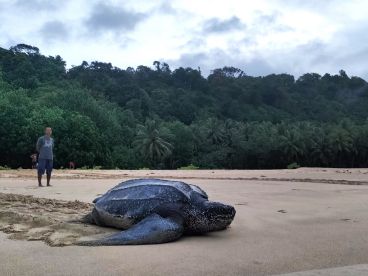
Leatherback turtle at the beach Buggeisiata on Sipora
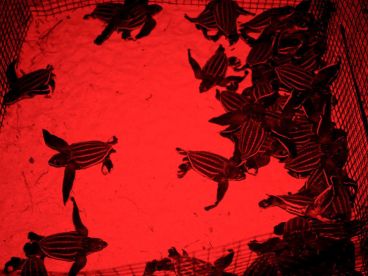
Protected nest of a leatherback turtle in the hatchery right before the release
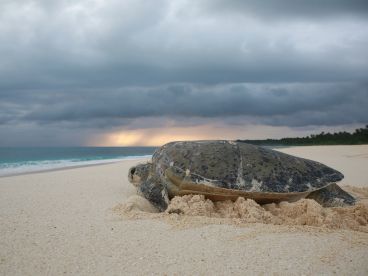
Green sea turtle after nesting in the sunset (Selaut Besar)
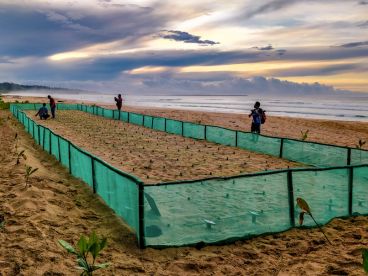
In our hatchery, the eggs of the leatherback can develop safely without disturbances
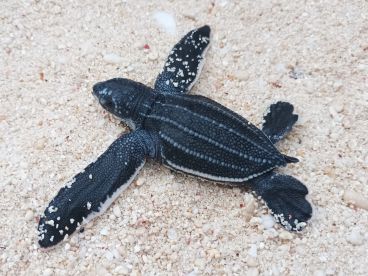
Young leatherback on its way to the sea
We pursue these goals
Our primary goal is to conserve the endangered species of sea turtles and help the populations to recover.
We also want to minimise the dangers caused by humans on four important sea turtle nesting beaches in West Sumatra and increase knowledge about these impressive reptiles among the local population.
The focus lies on these activities
- Protecting nesting females and their nests from poachers
- Employing local rangers and training them in sea turtle conservation
- Data collection and marking of nests
- Awareness-raising activities and environmental education for local communities
- Promoting alternative sources of income through sustainable beach utilisation and ecotourism
What else do we do for the sea turtles
In two villages, we have initiated conservation measures involving the local community and support alternative sources of income to reduce dependence on the trade in turtle eggs and turtleshell.
Through our satellite transmitter program, we have been able to gain insights into the migration of leatherback turtles. Animals we tagged on Selaut Besar and Along beach (Simeulue) led us as far as Western Australia.
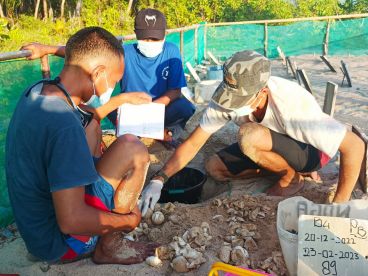
Scientific data collection of the nest in the hatchery
We’ve teamed up with
Our projects on Simeulue and Selaut Besar are carried out in cooperation with Yayasan Penyu Indonesia and Ecosystem Impact.
Take on a symbolic adoption for a sea turtle off the west coast of Sumatra now!
Banggai: anti-turtleshell project for hawksbill sea turtles
The hawksbill turtle (Eretmochelys imbricata) is considered the most beautiful of all sea turtles because of its colourful shell. With disastrous consequences for her survival. Because the corneous plates of their dorsal shell provide a coveted raw material: the so-called turtleshell.
Combs, glasses frames, decorative objects and jewellery made from turtleshell used to be widespread in Europe, too. Since the international trade of turtleshell was banned in 1977, they are mainly found in the tropical countries where the hawksbill turtle is native.
Why we do something for the hawksbill turtle
To this day, the hawksbill turtle is still heavily poached in some parts of the world due to its scutes. As a result, it is one of the most endangered sea turtle species in the world. One of the remaining populations inhabits the waters of Indonesia. By now, the animals are also a protected species here. However, the problem and the extent of turtleshell exploitation have not yet been sufficiently recognised by the authorities.
Where we did something: a nationwide campaign
Back in 2019, we and our Indonesian sister Yayasan Penyu Indonesia made a contribution to saving the remaining animals in Indonesia: we launched a nationwide anti-turtleshell campaign with the aim of influencing purchasing behaviour and associating the wearing of jewellery made from this raw material negatively in public. In fact, only a few locals are aware that the turtles die in agonising conditions during the extraction process. In order to obtain the material, their scutes are removed while they are still alive.
Continuation of the anti-turtleshell work: Banggai
Our last anti-turtleshell project developed out of our nationwide campaign. From mid-2022 to the end of 2023, we were focussing on one of the hotspots of the trade in tortoiseshell products – the village of Pulau Tembang in the district of Banggai in Central Sulawesi.
Cooperation with fishermen
Together with our friends AlTo (Alliance for Tompotika Conservation), we conducted a participatory village analysis to find out about the wishes of the population and the possibilities of supporting the village. For us, it was important not to criminalise the fishermen who catch turtles for financial reasons, but to find a common solution.
Besides the cultivation of red algae, which can be grown well in the region and have a good market value, we saw potential in supporting better marketing of the fish catch. We also involved fishermen in our data collection to investigate the occurrence of hawksbill turtles in their feeding grounds. With so-called ‘in-water monitoring’, we hoped to obtain data on the population on the region’s coral reefs. We were already able to carry out this methodology as a pilot study in Berau in 2014.
Very low number of critically endangered hawksbills spotted
Unfortunately, contrary to our assumptions, we only encountered very few hawksbill turtles at their nesting grounds by the end of the project. A total of 11 sightings were reported to us by the participating fishermen in the village. Additionally, we were only able to collect detailed scientific data from one animal as part of the in-water monitoring. We therefore decided to leave our project site in Banggai by the end of the year.
Campaigning in the region
In addition to the project work in Pulau Tembang, we decided to expand the approved campaign work in the Banggai region, which we had recently carried out nationwide to raise awareness about the cruel practice. In addition to school visits, Yayasan Penyu Indonesia organised a “Turtle Week” once a year in the district capital Luwuk. This was a series of several public events that also feature the mascot Kimi.
The anti-turtleshell project was funded by the Critical Ecosystem Partnership Fund (CEPF) for 18 months.

Anti-turtleshell stall at Turtle Week, Luwuk, Banggai, Indonesia

Women on raft cultivating the harvest of red algae on the shores of Pulau Tembang
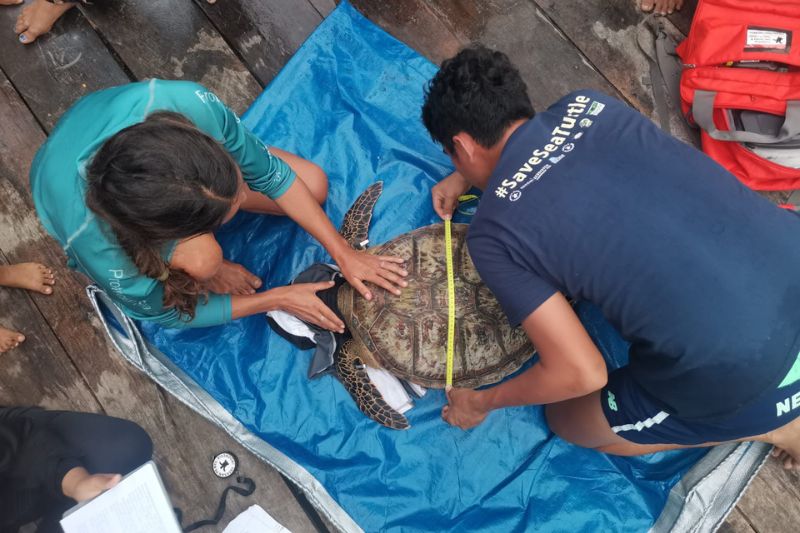
Collecting biometric data of a green sea turtle, Banggai, Indonesia
















